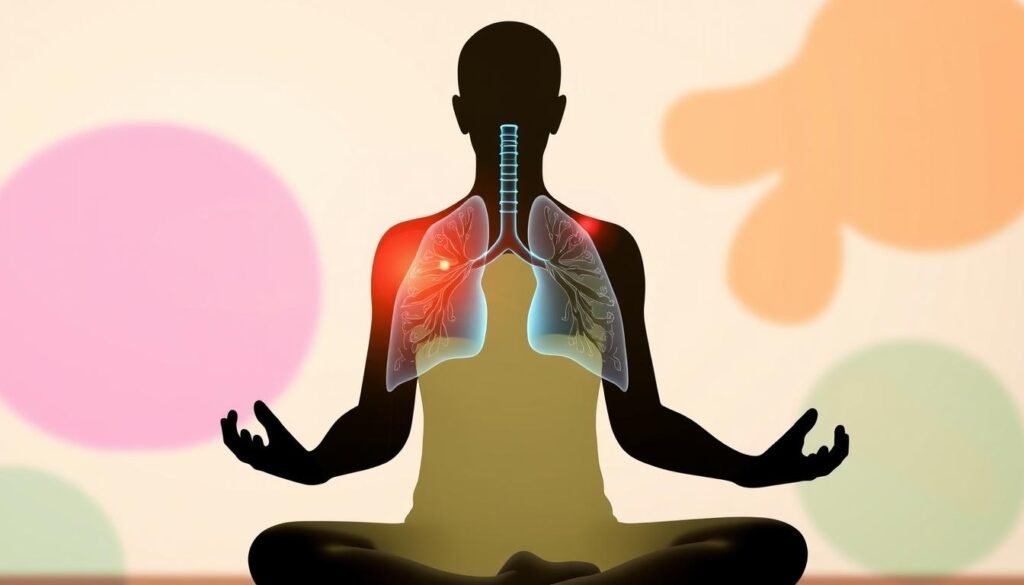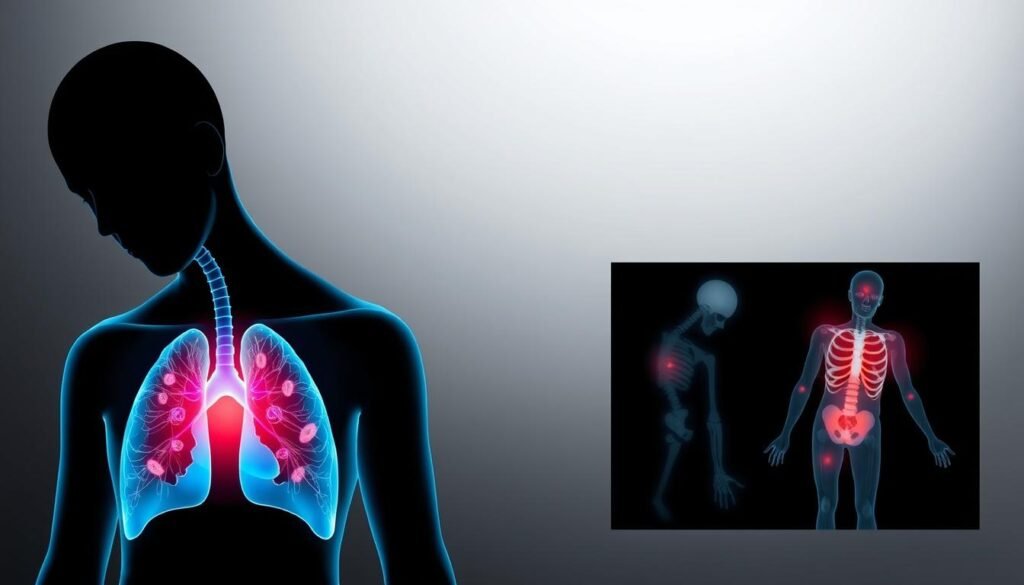Did you know a rare lung cancer called Pancoast tumors affects about 96% of people with it? They feel shoulder pain first. It’s a big sign of the link between shoulder pain and lung cancer. This makes many wonder if lung cancer can indeed cause shoulder pain. Knowing about this can help catch the disease early, which is key to fighting it. This guide will show you how lung cancer, like Pancoast tumors or mesothelioma, can lead to shoulder pain. Learning about this can help patients get better outcomes from their treatments.
Key Takeaways
- Pancoast tumors, making up 3-5% of lung cancer cases, often bring severe shoulder pain.
- Spotting the disease early matters, with a 56% chance of surviving 5 years for primary lung cancer.
- If you have shoulder pain, it might mean the lung cancer is in a late stage, especially with metastatic non-small-cell lung cancer.
- It might take up to 40 years for mesothelioma symptoms like shoulder pain to show after being exposed to asbestos.
- Knowing these symptoms means doctors can diagnose the cancer sooner, improving chances of beating it.
Understanding Shoulder Pain
Shoulder pain comes from different causes like injuries, swelling, or aging conditions. Common causes include muscle tears, arthritis, and pinched nerves. Yet, if the pain lasts, it could point to a serious issue like lung cancer. It’s crucial to get medical help if you also have lung cancer symptoms such as losing weight without trying or feeling very tired all the time.
Common Causes of Shoulder Pain
Many common conditions lead to shoulder pain, such as:
- Rotator cuff injuries
- Shoulder impingement
- Inflammatory conditions like tendonitis or bursitis
- Arthritis
- Nerve compression syndromes
These are usual reasons for shoulder pain. But, unusual patterns, like pain that gets worse at night, need attention. They could link to bigger health problems.
How Pain is Perceived in the Body
People feel pain differently. Understanding referred pain is key. This is when pain shows up in a different place than where it started. For example, shoulder pain might come from issues in the chest or neck. With lung cancer, this pain could be because cancer has spread to areas near the shoulder. Knowing the lung cancer symptoms linked with shoulder pain is vital for getting the right medical check-up.
Can Lung Cancer Cause Shoulder Pain?
Lung cancer can cause shoulder pain through what is called referred pain. This means the pain in the shoulder might actually be coming from the lungs. Tumors can push on tissues and nerves. This can make pain spread to the shoulders.
The Role of Referred Pain in Lung Cancer
Referred pain makes the brain get mixed up about where pain is coming from. People with lung cancer might feel shoulder pain even if it’s not the shoulder that’s sick. For example, Pancoast tumors often lead to shoulder pain. In fact, nearly all patients with this kind of tumor report feeling it.
Typical Symptoms Associated with Lung Cancer
Knowing all the symptoms of lung cancer can help catch it early. Common signs are:
- Persistent cough
- Shortness of breath
- Unexplained weight loss
- Fatigue
- Changes in voice or hoarseness
- Shoulder pain, though less commonly recognized
It’s very important to know these symptoms for lung cancer. Catching it early can change how well treatment works. This could help people live longer.

| Symptom | Likelihood of Occurrence |
|---|---|
| Persistent Cough | High |
| Shortness of Breath | High |
| Weight Loss | Medium |
| Fatigue | High |
| Shoulder Pain | Low |
Pancoast Tumors and Their Impact on Shoulder Pain
Pancoast tumors are a rare form of lung cancer, making up 3 to 5% of lung cancer cases. They start at the top of the lungs. The growth of these tumors can cause shoulder pain.
Because of their position, they can press on nerves. This pressure leads to intense pain. It spreads to the shoulder, arm, and upper back.
What Are Pancoast Tumors?
Pancoast tumors are mainly non-small cell lung cancers. Adenocarcinoma is the most usual type. These tumors are hard to spot on regular chest X-rays. Sometimes, even with Pancoast tumors, a chest X-ray can look normal.
About 1.7% of these cases may not show up without advanced scans such as CT, MRI, or PET-CT. Treatment depends on the cancer’s stage, where it is, and the patient’s health. Surgery, chemoradiotherapy, and immunotherapy are common treatments.
Symptoms of Pancoast Tumors
It’s key to know the symptoms of Pancoast tumors for early treatment. Pain is the most common symptom, affecting 44 to 96% of patients. The distinctive Pancoast-Tobias syndrome causes intense pain in the shoulder, neck, arm, and chest.
Other symptoms include:
- Horner’s syndrome, shown by a drooping eyelid, a small pupil, and less sweating on one side.
- Numbness, weakness, or tingling in the hand and arm, which means the brachial plexus might be compressed.
- Excessive sweating or face flushing on the affected side.
Knowing these signs can help catch the disease early. For more, readers can check this source. When dealing with Pancoast tumors, getting help from a team of cancer care experts is important.

Other Types of Lung Cancer Linked to Shoulder Pain
Shoulder pain can be a sign of various lung cancers, like metastatic lung cancer. This cancer starts in the lungs and can move to bones or nerves. Patients might feel pain from the shoulder to the arm as it spreads. It’s key to notice these pain patterns early for the best chance at treatment.
Understanding Metastatic Lung Cancer
Metastatic lung cancer can cause shoulder pain among other symptoms. The pain may come and go. It is unique because it doesn’t get worse when you move. Also, it can be a dull ache that’s worse at night. If you have shoulder pain with symptoms like shortness of breath, a constant cough, and tiredness, see a doctor.
Mesothelioma and Associated Symptoms
Mesothelioma, another lung cancer type, often links back to being exposed to asbestos. It doesn’t always cause shoulder pain, but it can. About 5% of cases with pleural mesothelioma report such discomfort. This pain is usually not severe. Sometimes, shoulder pain might be the first hint of mesothelioma. Other symptoms to watch for include chest pain and breathing troubles—both common signs. For more on how shoulder pain relates to lung cancer, visit this article.

| Type of Cancer | Shoulder Pain Rating | Additional Symptoms | Prevalence |
|---|---|---|---|
| Metastatic Lung Cancer | Variable (from mild to severe) | Shortness of breath, fatigue, persistent cough | Majority of lung cancer cases |
| Pancoast Tumors | Intense | Chest pain, weakness in arm | 3-5% of lung cancers |
| Mesothelioma | Mild (around 4/10) | Chest pain, coughing | 3,000 new cases annually |
Lung Cancer Progression and Pain Symptoms
Knowing how lung cancer changes is key to spotting symptoms like shoulder pain. Early detection helps a lot with treatment and patient results. Understanding how stages of lung cancer affect pain helps in getting medical help quick, especially if pain shows the disease is getting worse.
The Importance of Early Detection
Finding lung cancer early can really help survival rates and make life better. Spotting symptoms early opens up more treatment choices. This can make handling the disease more successful. It’s important to focus on screening and learning about lung cancer. This helps in seeing symptoms such as shoulder pain that might not be noticed otherwise. This kind of pain can mean the cancer is more advanced and needs quick medical attention. Pain usually means the cancer is in a late stage, so it’s important to keep checking on it.
Stages of Lung Cancer and Their Impact on Pain
Lung cancer is split into stages that affect the pain you feel and how bad it is. As cancer gets worse, the pain changes and can get worse. In serious cases, the cancer can spread to bones. This causes a lot of pain in places like the shoulders and back. For example, shoulder pain because of lung cancer can get worse when you lie down. This helps doctors figure out how the cancer is moving along.
To really grasp the stages of lung cancer and what pain they bring, see this table below. It has the stages and what kind of pain might come with each one.
| Stage of Lung Cancer | Possible Symptoms | Impact on Pain |
|---|---|---|
| Stage I | Cough, slight shoulder pain | Mild pain, often manageable |
| Stage II | Persistent cough, localized pain | Moderate pain, may begin to interfere with daily activities |
| Stage III | Severe cough, shoulder and back pain | Increased pain, often requiring stronger medications |
| Stage IV | Severe pain in multiple areas, including bones | Chronic pain, potential for palliative care needs |
Getting to know these stages and what pains they bring helps in spotting when cancer causes shoulder pain. Paying attention to these details is crucial for regular checks and timely tests. This is key to managing cancer effectively.
Diagnosing Shoulder Pain in Lung Cancer Patients
Finding the cause of shoulder pain in lung cancer patients needs a planned approach. Oncologists use different tests to find the root of shoulder pain. These tests are key in spotting problems early and treating them right.
Diagnostic Tests Used by Oncologists
Oncologists rely on several important tests to see if shoulder pain is linked to lung cancer. They use:
- CT Scans: These give clear images to spot tumors in and around the lungs.
- MRIs: These scans show detailed pictures of tissues and can find issues in the shoulder.
- Biopsies: Taking tissue samples helps confirm the type of lung cancer, like Pancoast tumors.
With these tools, doctors can tell if the pain is from lung cancer or something else. This guides them on how to manage the condition.
When to Seek Medical Attention
Knowing when to get help is key, especially if you’ve had lung cancer before. Look out for these signs:
- Unexplained shoulder pain: This is common in patients with signs of lung cancer.
- Changes in neurologic function: Issues like a droopy eyelid show Horner’s syndrome from Pancoast tumors.
- Accompanying symptoms: Sudden weight loss, coughing up blood, or more trouble breathing mean you should see a doctor soon.
Getting help quickly can make a big difference in treatment success and life quality. Being aware of these symptoms encourages actively seeking care, leading to better health outcomes.
Cancer Treatment Options for Shoulder Pain Relief
Many people with lung cancer experience shoulder pain. There are many treatments aimed at easing this discomfort. Getting the right pain management plan can greatly improve life quality. These plans may include various medications and other therapies to tackle the pain’s root and symptoms.
Medications and Pain Management Techniques
Medications are a key part of managing lung cancer pain. NSAIDs can reduce inflammation and ease pain. For intense pain, opioids might be used, especially after surgery or with metastatic cancer. Besides drugs, physical therapy, acupuncture, and mindfulness also help in relieving pain and boosting well-being.
Role of Palliative Care in Cancer Treatment
Palliative care aims to improve life quality for patients with serious illnesses, like lung cancer. It takes care of physical, emotional, and psychological pain. Teams create detailed plans for managing pain and providing support. This care meets each person’s needs, which helps them cope better and improves their health.
To learn how spotting symptoms like shoulder pain early can aid in finding effective cancer treatments, see this detailed resource.
Managing Shoulder Pain Effectively
Dealing with shoulder pain needs different strategies, especially with lung cancer challenges. Good management involves therapy and rehab techniques aimed at better movement and easing pain. Also, using home remedies for pain relief lets patients manage their pain better.
Physical Therapy and Rehabilitation
Physical therapy is very important in controlling shoulder pain. Tailored exercises help improve motion and lessen pain, especially for lung cancer patients. These may involve:
- Stretching exercises to improve flexibility.
- Strengthening exercises focusing on the shoulder and nearby muscles.
- Manual therapy to reduce stiffness and encourage healing.
- Therapeutic modalities, like ultrasound or electrical stimulation, for pain reduction.
Working with an expert physical therapist makes sure the exercises are right and safe. This is based on the patient’s health and specific pain issues.
Home Remedies for Pain Relief
Home remedies can help with professional shoulder pain treatment. Effective methods include:
- Heat therapy, using warm compresses, can ease muscle tension and cut down pain.
- Ice applications reduce swelling and relieve sharp pain.
- Gentle stretching helps improve movement and lessen stiffness.
- Ergonomic adjustments in daily life can stop added shoulder strain.
Using these remedies encourages taking an active role in pain management. It improves life quality for those dealing with shoulder pain from lung cancer.
Conclusion
It’s vital to understand how lung cancer and shoulder pain might be connected. Sometimes, lung cancer can cause shoulder pain through referred pain. This is especially true for Pancoast tumors.
This kind of tumor can make your arm weak, numb, or swollen. If you notice these signs early, you can get help sooner. Surprisingly, about 48% of lung cancer patients may stop smoking on their own before they even know they have cancer. This fact highlights how important it is to pay attention to any lung cancer-related symptoms.
Being aware of conditions like hypercalcemia is also helpful. This condition affects 10% to 20% of people with cancer. If you suddenly feel very thirsty or have bad shoulder pain, you should see a doctor. Even though shoulder pain is common, always check out persistent or strange pain. It might be a clue that lung cancer is getting worse.
The best thing to do is to get regular checks and watch for any health changes. People who have smoked a lot should get checked every year for lung cancer. Catching and treating lung cancer early is crucial. This disease is the top cause of death from cancer all over the world.